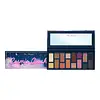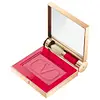What's inside
What's inside
 Key Ingredients
Key Ingredients

 Benefits
Benefits

 Concerns
Concerns

 Ingredients Side-by-side
Ingredients Side-by-side

Mica
Cosmetic ColorantMagnesium Myristate
Silica
AbrasiveBoron Nitride
AbsorbentCaprylic/Capric Triglyceride
MaskingOryza Sativa Extract
AbsorbentSynthetic Fluorphlogopite
Lac
Skin ConditioningCalcium Aluminum Borosilicate
Dimethicone
EmollientDiisostearyl Malate
EmollientLauroyl Lysine
Skin ConditioningTin Oxide
AbrasiveTrimethylsiloxysilicate
EmollientParfum
MaskingLimonene
PerfumingLinalool
PerfumingCitral
PerfumingCinnamal
PerfumingHexyl Cinnamal
PerfumingGeraniol
PerfumingSodium Dehydroacetate
PreservativePhenoxyethanol
PreservativeSorbic Acid
PreservativeCI 77891
Cosmetic ColorantCI 77491
Cosmetic ColorantCI 77742
Cosmetic ColorantCI 77499
Cosmetic ColorantCI 75470
Cosmetic ColorantCalcium Sodium Borosilicate
Neopentyl Glycol Diheptanoate
EmollientIsododecane
EmollientOctyldodecyl Stearoyl Stearate
EmollientCaprylyl Glycol
EmollientAcrylates Copolymer
1,2-Hexanediol
Skin ConditioningPolyglyceryl-10 Pentaisostearate
EmollientCI 77000
Cosmetic ColorantCI 77400
Cosmetic ColorantCI 77492
Cosmetic ColorantCI 77163
Cosmetic ColorantDisodium Stearoyl Glutamate
CleansingTriethoxycaprylylsilane
Aluminum Dimyristate
Emulsion StabilisingCI 77007
Cosmetic ColorantMica, Magnesium Myristate, Silica, Boron Nitride, Caprylic/Capric Triglyceride, Oryza Sativa Extract, Synthetic Fluorphlogopite, Lac, Calcium Aluminum Borosilicate, Dimethicone, Diisostearyl Malate, Lauroyl Lysine, Tin Oxide, Trimethylsiloxysilicate, Parfum, Limonene, Linalool, Citral, Cinnamal, Hexyl Cinnamal, Geraniol, Sodium Dehydroacetate, Phenoxyethanol, Sorbic Acid, CI 77891, CI 77491, CI 77742, CI 77499, CI 75470, Calcium Sodium Borosilicate, Neopentyl Glycol Diheptanoate, Isododecane, Octyldodecyl Stearoyl Stearate, Caprylyl Glycol, Acrylates Copolymer, 1,2-Hexanediol, Polyglyceryl-10 Pentaisostearate, CI 77000, CI 77400, CI 77492, CI 77163, Disodium Stearoyl Glutamate, Triethoxycaprylylsilane, Aluminum Dimyristate, CI 77007
Synthetic Fluorphlogopite
Mica
Cosmetic ColorantDimethicone
EmollientC12-15 Alkyl Benzoate
AntimicrobialCI 77163
Cosmetic ColorantTalc
AbrasiveHydrogenated Polyisobutene
EmollientCI 77891
Cosmetic ColorantCI 75470
Cosmetic ColorantBoron Nitride
AbsorbentCalcium Aluminum Borosilicate
Magnesium Stearate
Cosmetic ColorantCI 77007
Cosmetic ColorantSilica
AbrasiveHydrogenated Styrene/Butadiene Copolymer
Parfum
MaskingCaprylyl Glycol
EmollientSorbitan Isostearate
EmulsifyingIsododecane
EmollientMethicone
EmollientMagnesium Silicate
AbsorbentAlumina
AbrasiveLinalool
PerfumingLimonene
PerfumingCI 19140
Cosmetic ColorantCitronellol
PerfumingBenzyl Alcohol
PerfumingCitrus Aurantium Bergamia Fruit Oil
MaskingGeraniol
PerfumingTin Oxide
AbrasiveCitral
PerfumingTris-BHT Mesitylene
AntioxidantTocopherol
AntioxidantSynthetic Fluorphlogopite, Mica, Dimethicone, C12-15 Alkyl Benzoate, CI 77163, Talc, Hydrogenated Polyisobutene, CI 77891, CI 75470, Boron Nitride, Calcium Aluminum Borosilicate, Magnesium Stearate, CI 77007, Silica, Hydrogenated Styrene/Butadiene Copolymer, Parfum, Caprylyl Glycol, Sorbitan Isostearate, Isododecane, Methicone, Magnesium Silicate, Alumina, Linalool, Limonene, CI 19140, Citronellol, Benzyl Alcohol, Citrus Aurantium Bergamia Fruit Oil, Geraniol, Tin Oxide, Citral, Tris-BHT Mesitylene, Tocopherol
Ingredients Explained
These ingredients are found in both products.
Ingredients higher up in an ingredient list are typically present in a larger amount.
Boron Nitride is compound consisting of boron and nitrogen. It is used to absorb oil and modify adherence/ slip in products.
This means it is often used in makeup products to help them last longer.
Calcium Aluminum Borosilicate is made up of calcium, aluminum, and silicates. It is a glass-like material. In cosmetics, it comes in the form of flakes or microspheres.
Calcium aluminum borosilicate is a bulking agent, meaning it helps thicken a product.
This ingredient is created by slowly mixing several minerals, including kaolin clay.
Although “aluminum” in an ingredient name can raise red flags for some consumers, the form and usage context matter significantly. For typical topical applications, there is no substantial evidence of health risks - such as cancer, neurotoxicity, or systemic “aluminum overload.”
Learn more about Calcium Aluminum BorosilicateCaprylyl Glycol is a humectant and emollient, meaning it attracts and preserves moisture.
It is a common ingredient in many products, especially those designed to hydrate skin. The primary benefits are retaining moisture, skin softening, and promoting a healthy skin barrier.
Though Caprylyl Glycol is an alcohol derived from fatty acids, it is not the kind that can dry out skin.
This ingredient is also used as a preservative to extend the life of products. It has slight antimicrobial properties.
Learn more about Caprylyl GlycolCi 75470 is a bright-red pigment. It is AKA carmine.
Carmine is derived from insects such as the cochineal beetle. This ingredient has been used as a natural dye for over 2000 years.
This pigment is called Ultramarine blue lazurite. It gives a saturated blue color, but can be used to create other colors as well.
According to the manufacturer, it is usually made from kaolin, sodium sulfate, sodium carbonate, sulfur, and charcoal.
This synthetic powder is used to add a pearly/white color in cosmetics.
Ci 77891 is a white pigment from Titanium dioxide. It is naturally found in minerals such as rutile and ilmenite.
It's main function is to add a white color to cosmetics. It can also be mixed with other colors to create different shades.
Ci 77891 is commonly found in sunscreens due to its ability to block UV rays.
Learn more about CI 77891Citral is a fragrance and used to add a lemon-like scent to products. It is both naturally found in plants and created synthetically. In plants, it is commonly occurring in lemon myrtle, lemongrass, lemon tea-tree, lemon verbena, and other citruses.
The EU mandates Citral be listed separately as a fragrance. It is a known allergen and may cause contact dermatitis. Citral can also used as a masking ingredient.
The term 'fragrance' is not regulated in many countries. In many cases, it is up to the brand to define this term. For instance, many brands choose to label themselves as "fragrance-free" because they are not using synthetic fragrances. However, their products may still contain ingredients such as essential oils that are considered a fragrance.
The term 'citral' is a collective term for two geometric isomers: geranial/Citral A and neral/Citral B.
Learn more about CitralDimethicone is a type of synthetic silicone created from natural materials such as quartz.
What it does:
Dimethicone comes in different viscosities:
Depending on the viscosity, dimethicone has different properties.
Ingredients lists don't always show which type is used, so we recommend reaching out to the brand if you have questions about the viscosity.
This ingredient is unlikely to cause irritation because it does not get absorbed into skin. However, people with silicone allergies should be careful about using this ingredient.
Note: Dimethicone may contribute to pilling. This is because it is not oil or water soluble, so pilling may occur when layered with products. When mixed with heavy oils in a formula, the outcome is also quite greasy.
Learn more about DimethiconeGeraniol is used to add fragrance/parfum to a product. It is the main component of citronellol. It is a monoterpenoid and an alcohol.
Monoterpenes are naturally found in many parts of different plants.
Geraniol can be found in many essential oils including Rose Oil and Citronella Oil. The scent of Geraniol is often described as "rose-like". Many foods also contain Geraniol for fruit flavoring.
Geraniol can irritate the skin when exposed to air. However, irritation depends on the ability of geraniol to penetrate into the skin. In general, geraniol is not able to penetrate skin easily.
Geraniol is colorless and has low water-solubility. However, it is soluble in common organic solvents.
Like citronellol, it is a natural insect repellent.
2,6-Octadien-1-ol, 3,7-dimethyl-, (2E)-
Learn more about GeraniolIsododecane is a fragrance, emollient, and solvent.
As an emollient, it helps your skin stay soft and hydrated. Emollients help trap moisture into your skin.
Isododecane's role as a solvent makes it a great texture enhancer. It spreads smoothly on skin and does not leave a sticky feeling behind. Isododecane also helps prevent color transfer in makeup products.
Isododecane is not absorbed into skin.
Learn more about IsododecaneLimonene is a fragrance that adds scent and taste to a formulation.
It's found in the peel oil of citrus fruits and other plants such as lavender and eucalyptus. The scent of limonene is generally described as "sweet citrus".
Limonene acts as an antioxidant, meaning it helps neutralize free radicals.
When exposed to air, oxidized limonene may sensitize the skin. Because of this, limonene is often avoided by people with sensitive skin.
The term 'fragrance' is not regulated in many countries. In many cases, it is up to the brand to define this term. For instance, many brands choose to label themselves as "fragrance-free" because they are not using synthetic fragrances. However, their products may still contain ingredients such as essential oils that are considered a fragrance.
Learn more about LimoneneLinalool is a fragrance and helps add scent to products. It's derived from common plants such as cinnamon, mint, citrus, and lavender.
Like Limonene, this ingredient oxidizes when exposed to air. Oxidized linalool can cause allergies and skin sensitivity.
This ingredient has a scent that is floral, spicy tropical, and citrus-like.
Learn more about LinaloolMica is a naturally occurring mineral used to add shimmer and color in cosmetics. It can also help improve the texture of a product or give it an opaque, white/silver color.
Serecite is the name for very fine but ragged grains of mica.
This ingredient is often coated with metal oxides like titanium dioxide. Trace amounts of heavy metals may be found in mica, but these metals are not harmful in our personal products.
Mica has been used since prehistoric times throughout the world. Ancient Egyptian, Indian, Greek, Roman, Aztec, and Chinese civilizations have used mica.
Learn more about MicaParfum is a catch-all term for an ingredient or more that is used to give a scent to products.
Also called "fragrance", this ingredient can be a blend of hundreds of chemicals or plant oils. This means every product with "fragrance" or "parfum" in the ingredients list is a different mixture.
For instance, Habanolide is a proprietary trade name for a specific aroma chemical. When used as a fragrance ingredient in cosmetics, most aroma chemicals fall under the broad labeling category of “FRAGRANCE” or “PARFUM” according to EU and US regulations.
The term 'parfum' or 'fragrance' is not regulated in many countries. In many cases, it is up to the brand to define this term.
For instance, many brands choose to label themselves as "fragrance-free" because they are not using synthetic fragrances. However, their products may still contain ingredients such as essential oils that are considered a fragrance by INCI standards.
One example is Calendula flower extract. Calendula is an essential oil that still imparts a scent or 'fragrance'.
Depending on the blend, the ingredients in the mixture can cause allergies and sensitivities on the skin. Some ingredients that are known EU allergens include linalool and citronellol.
Parfum can also be used to mask or cover an unpleasant scent.
The bottom line is: not all fragrances/parfum/ingredients are created equally. If you are worried about fragrances, we recommend taking a closer look at an ingredient. And of course, we always recommend speaking with a professional.
Learn more about ParfumSilica, also known as silicon dioxide, is a naturally occurring mineral. It is used as a fine, spherical, and porous powder in cosmetics.
Though it has exfoliant properties, the function of silica varies depending on the product.
The unique structure of silica enhances the spreadability and adds smoothness, making it a great texture enhancer.
It is also used as an active carrier, emulsifier, and mattifier due to its ability to absorb excess oil.
In some products, tiny microneedles called spicules are made from silica or hydrolyzed sponge. When you rub them in, they lightly polish away dead skin layers and enhance the penetration of active ingredients.
Learn more about SilicaSynthetic Fluorphlogopite is the synthethic version of mica. It consists of fluorine, aluminum and silicate.
Synthetic Fluorphlogopite is used to add volume to products.
It is considered non-irritating on the skin.
Learn more about Synthetic FluorphlogopiteTin Oxide is an inorganic oxide used to add opacity and volume to a product. In nature, it is already found in mineral form. The main ore of tin is an opaque and shiny mineral called casseterite.
Tin Oxide helps remove translucency in a product, or make it more opaque. Besides adding opacity, tin oxide is used for bulking to add volume.